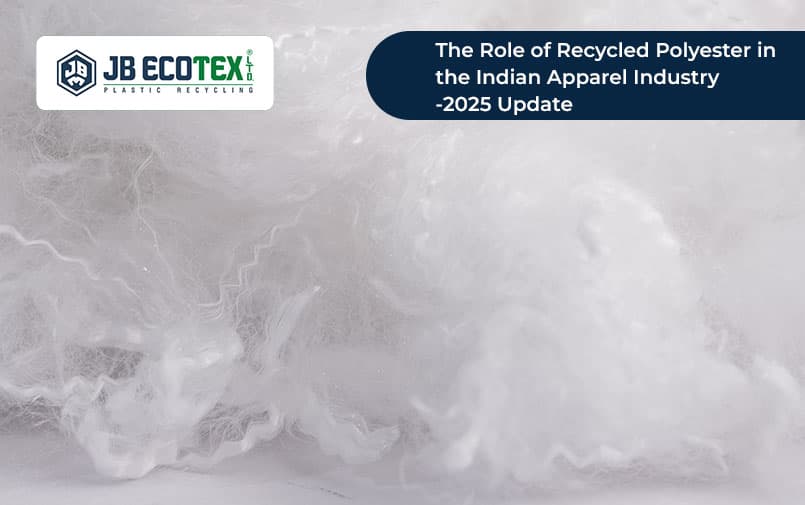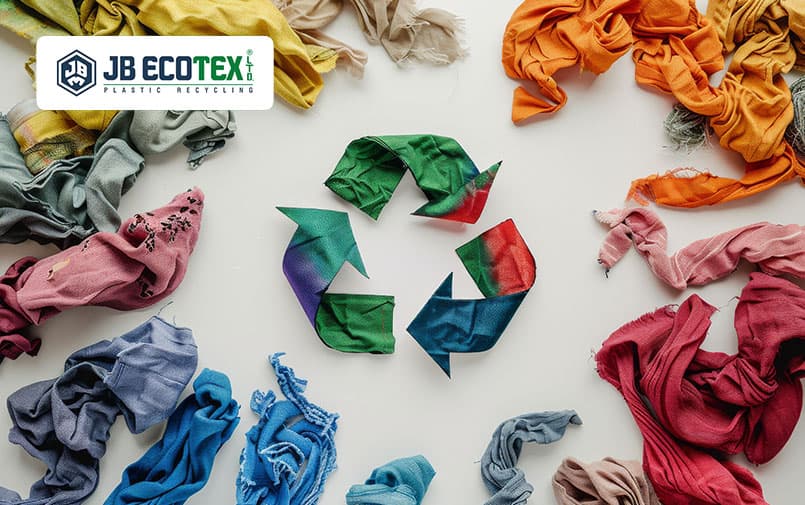The Role of Recycled Polyester in the Indian Apparel Industry— 2025 Update

Walk through any textile mill in Gujarat or Tamil Nadu in 2025, and you’ll notice something subtle. The bales of fiber stacked in the corner don’t look very different from a decade ago.. soft, white, slightly crimped. But what they’re made of, and what they represent, has changed.
Those fibers didn’t begin life in a petrochemical plant. They started as bottles: collected, washed, shredded, and melted down to form what’s now known, across the supply chain, as recycled polyester staple fiber.
It’s not a revolution. But it is movement. And it’s happening steadily.
India’s Role in the Global Polyester Fiber Market
It is reported by Research and Markets that India is one of the world’s largest producers of synthetic fibers. In 2024, the country produced approximately 4.52 million metric tonnes of synthetic fiber, of which polyester filament yarn accounted for more than half. While virgin polyester fiber remains dominant, recycled alternatives are gaining ground, particularly in export-focused manufacturing.
According to TechSci Research, India’s polyester staple fiber market was valued at USD 1.54 billion in 2023, with an expected CAGR of 4.25% through 2029. A notable share of this growth could be attributed to demand for recycled inputs.

Inside the Recycled Polyester Staple Fiber Process
Recycled polyester staple fiber, or recycled PSF, is typically made from used PET bottles. These are collected, cleaned, and converted into PET flakes, which are then extruded into fibers. This process is less energy-intensive than the production of virgin polyester and reduces the volume of plastic waste sent to landfills or oceans.
Modern recycled polyester staple fiber plants in India are equipped to process large volumes of waste into high-quality fiber that meets specifications for spinning, weaving, and knitting. Depending on the application, the fiber can be used in garments, home furnishings, automotive fabrics, insulation, or nonwovens.
The presence of certified plants with GRS (Global Recycled Standard), ISO 14001, and Oeko-Tex certification has also helped Indian suppliers meet the growing expectations of global buyers.
Circularity Targets Are Driving Procurement Strategy
Global apparel brands are facing increased pressure to disclose the environmental impact of their materials. The European Union’s Product Environmental Footprint (PEF) framework, extended producer responsibility (EPR) policies in India, and voluntary goals set by large fashion groups are shifting procurement behavior.
Many brands sourcing from South Asia have publicly committed to increasing their use of recycled polyester across product lines. Textile Exchange confirms that the 2025 Recycled Polyester Challenge had 121 signatories in early 2025, with 57% of them committed to replacing 100% of virgin fossil-based polyester with recycled by 2025.
For manufacturers, this means that producing regenerated polyester staple fiber has gone from being an optional sustainability upgrade to a prerequisite to stay eligible for long-term contracts.
Sportswear and Performance Textiles Set the Benchmark
Some of the most notable applications of recycled PSF are in performance wear and sports apparel.
Puma’s RE:FIBRE program, launched in 2024, has already introduced millions of football jerseys made with at least 75% recycled textile waste. The jerseys are being worn by over 35 football clubs globally. Puma is also piloting chemical and thermo-mechanical recycling in India to shift away from relying solely on bottle-based sources for recycled content.
Brands like Adidas and Decathlon continue to use recycled polyester staple fiber in their Indian supply chains. These brands have set technical requirements that ensure the recycled material performs at par with conventional inputs in terms of durability, stretch, and color retention.
India’s Textile Ecosystem is Adapting
To meet this growing demand, new investments are being made across the textile value chain.
Modern recycled polyester staple fiber plants are scaling operations to improve yield, color uniformity, and denier consistency. Manufacturers are adopting automatic sorting and flake-cleaning systems to increase feedstock quality. Some players are also building integrated recycling lines that handle PET bottles through to finished fiber in a single facility.
Certification and traceability are now standard. Exporters are required to maintain clear documentation on fiber source, processing method, and compliance with environmental and social standards. In 2025, it is increasingly common for buyers to request LCA (life cycle assessment) data and batch-wise test reports from their suppliers.

Designers Are Engaging With Recycled Materials
In India’s designer and premium retail segment, use of recycled polyester staple fiber is growing steadily, although volumes remain smaller.
Labels like Doodlage are blending recycled PSF with deadstock fabrics and organic cotton to create ready-to-wear collections. Others are experimenting with structure and texture using regenerated polyester staple fiber, especially for nontraditional silhouettes.
What’s different in 2025 is that designers no longer need to compromise on finish or feel when working with recycled fibers. Processing improvements now make it possible to source material that meets premium aesthetic requirements.
Regulatory Landscape Is Evolving
India’s regulatory framework around circular textiles is developing in parallel with global trends.
The Bureau of Indian Standards (BIS) is currently working on guidelines for recycled fiber quality and labeling. The Ministry of Textiles has extended financial incentives under the PLI Scheme to cover recycling and circular economy projects. And the Central Pollution Control Board (CPCB) is enforcing more stringent EPR obligations on PET usage and recovery.
While not yet fully aligned with EU regulations, India’s domestic framework is creating a clearer roadmap for investment in recycled polyester staple fiber infrastructure.
Challenges in Feedstock and Scale
Despite momentum, several constraints remain. Collection systems for PET bottles are still uneven across Indian states. Inconsistent feedstock quality impacts fiber yield and cost. Dyeing and finishing recycled fiber can require process adjustments.
Smaller manufacturers face capital constraints in upgrading equipment or obtaining certifications. And for some product categories, recycled inputs still carry a cost premium over virgin.
That said, economies of scale are improving. Buyers are increasingly willing to commit to longer contracts that support stable pricing and capacity planning. With projected volume increases, these structural limitations are expected to reduce over time.
What Comes Next
In 2025, recycled polyester staple fiber is not a silver bullet. But it is a credible, scalable option that meets both environmental and performance needs across multiple product categories.
In India, recycled PSF production involves ongoing attention to infrastructure, certification, and feedstock sourcing. These elements form the basis of a more organized recycling ecosystem.
More importantly, the country’s textile sector now has an opportunity to align its production logic with long-term environmental goals without losing competitiveness.

JB Ecotex’s Recycled Polyester Fiber Imperative
The next time you look at a product label that reads “contains recycled polyester,” there’s a growing chance that fiber came from an Indian facility. Not because it was cheap. But because the supply chain has matured to meet a new kind of expectation, one that’s based on measurable impact and traceable inputs.
As the demand for circular materials grows, recycled polyester staple fiber continues to play a significant role in supporting more sustainable textile production. Across the value chain, producers are developing fibers for varied applications including apparel, insulation, automotive interiors, and home furnishings. The uses differ, but the focus on circularity remains consistent.
Companies like JB Ecotex, which has been producing recycled fiber for over a decade, reflect how this shift has taken shape over time. The systems, certifications, and sourcing infrastructure required to produce at scale aren’t built overnight. That foundation that is built through years of investment and operational refinement is what positions long-standing manufacturers to respond to today’s demand with both speed and consistency.
If your business is exploring certified, high-quality recycled polyester staple fiber for apparel, furnishings, or export manufacturing, JB Ecotex offers the scale, experience, and reliability to support that shift. To learn more about sourcing options or technical specifications, get in touch with our team or visit jbecotex.com.
